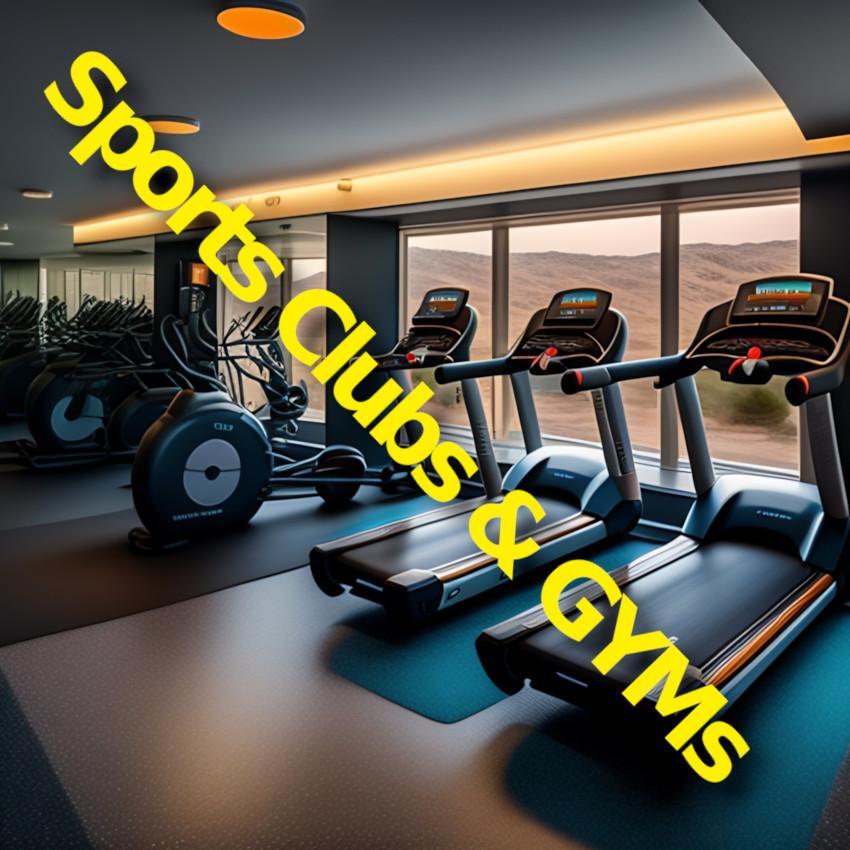


Sports clubs and gyms serve as dynamic hubs for individuals pursuing health, wellness, and athletic excellence. These establishments offer a diverse range of facilities, equipment, and programs tailored to various fitness goals and preferences. In this comprehensive guide, we'll explore the world of sports clubs and gyms, providing insights into their offerings and sharing useful tips for maximizing your fitness journey.
The Evolution of Sports Clubs and Gyms:
Sports clubs and gyms have evolved from traditional athletic centers to multifaceted facilities catering to diverse fitness interests. Modern clubs and gyms offer state-of-the-art equipment, group fitness classes, personal training services, and specialized amenities.
Choosing the Right Sports Club or Gym:
Selecting the right sports club or gym is essential for a fulfilling fitness experience. Consider factors such as location, membership options, facility amenities, and the variety of fitness programs offered. Take advantage of trial memberships or facility tours to assess compatibility with your fitness goals.
Understanding Facility Amenities:
Sports clubs and gyms boast an array of amenities designed to enhance the fitness experience. From cardio and strength training equipment to swimming pools, saunas, and sports courts, familiarize yourself with the available facilities and their accessibility.
Group Fitness Classes for Motivation:
Group fitness classes provide motivation, camaraderie, and structured workouts led by certified instructors. Choose classes that align with your interests and fitness goals, whether it's high-intensity interval training (HIIT), yoga, cycling, or dance-based workouts.
Personal Training for Individualized Guidance:
Personal training services offer individualized guidance, accountability, and tailored workout plans. Work with certified trainers to set realistic goals, track progress, and receive personalized instruction and support throughout your fitness journey.
Setting Realistic Fitness Goals:
Establishing realistic fitness goals is crucial for long-term success. Set specific, measurable, achievable, relevant, and time-bound (SMART) goals that align with your aspirations and capabilities. Regularly reassess and adjust your goals as you progress.
Balancing Cardiovascular and Strength Training:
Achieve a well-rounded fitness regimen by balancing cardiovascular exercise with strength training. Cardio workouts improve cardiovascular health, endurance, and calorie burn, while strength training builds muscle strength, bone density, and metabolism.
Nutrition and Hydration for Performance:
Proper nutrition and hydration are fundamental for optimizing performance and recovery. Fuel your body with a balanced diet rich in whole foods, lean proteins, complex carbohydrates, and healthy fats. Stay hydrated before, during, and after workouts to maintain peak performance.
Rest and Recovery for Well-being:
Prioritize rest and recovery to prevent overtraining and promote overall well-being. Incorporate rest days into your workout schedule, prioritize quality sleep, and practice relaxation techniques such as meditation, foam rolling, or yoga to reduce stress and muscle tension.
Community Engagement and Support:
Engage with the sports club or gym community to foster motivation, accountability, and support. Participate in social events, join fitness challenges, and connect with like-minded individuals who share your passion for health and wellness.
Safety and Injury Prevention:
Prioritize safety and injury prevention during workouts. Warm up properly before exercising, use proper form and technique, and listen to your body's cues. Gradually progress intensity and seek professional guidance if you experience pain or discomfort.
Lifelong Commitment to Fitness:
Embrace fitness as a lifelong journey and commit to consistency and perseverance. Celebrate progress, stay adaptable to change, and cultivate a positive mindset toward health and wellness. Remember, every step forward is a triumph toward a healthier, happier life.
The sports clubs and gyms industry is a sector of the fitness and recreation industry that provides services for individuals seeking to improve their physical fitness, health, and wellness through exercise and physical activity. This industry includes a wide range of establishments, including health clubs, fitness centers, gyms, yoga studios, and other recreational facilities.
The industry has experienced significant growth in recent years due to increasing awareness of the importance of fitness and wellness, as well as the rise of boutique fitness studios and specialized fitness programs.
Sports clubs and gyms typically offer a variety of amenities and services, such as cardio and weight-training equipment, group fitness classes, personal training, nutrition counseling, and spa services. They may also offer specialized programs and classes, such as dance fitness, yoga, Pilates, or martial arts.
Membership fees are a primary source of revenue for sports clubs and gyms. Memberships may be sold on a monthly or annual basis and may include different levels of access to facilities and services. Many facilities also offer day passes or drop-in rates for non-members.
In addition to membership fees, sports clubs, and gyms may generate revenue through the sale of merchandise, such as apparel and supplements, and through partnerships with local businesses and organizations.
The sports clubs and gyms industry is highly competitive, and success depends on providing high-quality services and amenities that meet the needs and preferences of members. Customer service, cleanliness, and convenience are also important factors in attracting and retaining members.
There are many different types of sports clubs and gyms, each catering to different fitness interests and goals. Here are some common types:
Health clubs: These are typically large facilities with a wide range of amenities, including cardio and weight-training equipment, group fitness classes, personal training, and sometimes swimming pools, saunas, and other spa services.
Specialty gyms: These may focus on a particular type of fitness or training, such as yoga, Pilates, martial arts, boxing, or CrossFit.
Boutique fitness studios: These are smaller, specialized fitness studios that offer classes in specific areas such as cycling, barre, dance, or high-intensity interval training (HIIT).
24-hour fitness centers: These facilities are open 24 hours a day, allowing members to work out at any time.
Corporate gyms: These gyms are typically located within a company's office building or campus and are available exclusively to employees.
Women-only gyms: These facilities cater specifically to women and may offer a more supportive and comfortable environment for women who may be uncomfortable working out in a co-ed gym.
Functional fitness facilities: These gyms focus on functional training that mimics everyday movements and may incorporate equipment such as kettlebells, sandbags, and suspension trainers.
Community centers: These are public facilities that may offer fitness classes, indoor and outdoor sports facilities, and other recreational programs for all ages.
Sports-specific facilities: These are facilities that cater to athletes or specific sports, such as basketball, soccer, or tennis. They may offer specialized equipment and training programs for athletes.
Before going to sports clubs or gyms, here are some things you should know:
Your health status: Make sure to check with your doctor before starting a new exercise program, especially if you have any underlying health conditions or are recovering from an injury.
The gym's policies: Familiarize yourself with the gym's policies and rules, such as the dress code, hours of operation, and equipment usage. Some gyms may also require masks or have specific protocols for cleaning and disinfecting equipment.
Your fitness goals: Determine what you want to achieve through your workout routine. Are you looking to build muscle, lose weight, or improve your cardiovascular health? Knowing your goals can help you create a plan that aligns with your objectives.
Proper form and technique: Proper form and technique are crucial for avoiding injury and getting the most out of your workout. If you are unsure about how to perform an exercise correctly, seek guidance from a trainer or fitness professional.
Hydration and nutrition: Staying hydrated and fueling your body with the proper nutrition is essential for maximizing your workout's benefits. Make sure to drink plenty of water before, during, and after your workout, and eat a balanced diet that includes protein, carbohydrates, and healthy fats.
Rest and recovery: Allow your body time to rest and recover between workouts. Overexertion can lead to injury and may hinder your progress toward your fitness goals. Consider incorporating rest days and active recovery into your exercise routine.
Personal hygiene: Gyms and sports clubs can be breeding grounds for germs and bacteria, so it's essential to practice good personal hygiene. Wash your hands frequently, bring a towel to wipe down equipment before and after use, and avoid working out when you're sick.
Sports clubs and gyms serve as catalysts for personal transformation and holistic well-being. By choosing the right facility, setting realistic goals, balancing workouts, and prioritizing nutrition and recovery, individuals can embark on a fulfilling fitness journey that transcends physical boundaries. Embrace the power of community, stay committed to your goals, and let the journey toward health and wellness inspire you to reach new heights of vitality and vitality.
Sincerely yours,

We use cookies
We use cookies and other tracking technologies to improve your browsing experience on our website, to show you personalized content and targeted ads, to analyze our website traffic, and to understand where our visitors are coming from. Privacy Policy.